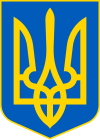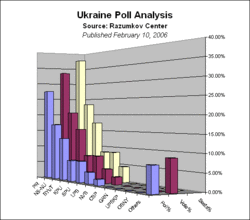2006 Ukrainian parliamentary election: Difference between revisions
added ecternal link Polls |
Ukraine2006 (talk | contribs) added groah and link to additional poll analysis |
||
| Line 9: | Line 9: | ||
==Polls== |
==Polls== |
||
[[Image:HPIM6182-nicaan041226.JPG|thumb|right|250px|Polling station in [[Dnipropetrovsk Oblast]], 3rd round, 26 XII 2004]] |
[[Image:HPIM6182-nicaan041226.JPG|thumb|right|250px|Polling station in [[Dnipropetrovsk Oblast]], 3rd round, 26 XII 2004]] |
||
[[Image:UkrainePollGraphRazumkovFeb2006.gif|thumb|Right|250px|Graph showing latest poll Jan(2)by Ruzumkov Feb 2006]] |
|||
In October 2005 and January 2006, Razumkov Centre held a respresentative national survey. |
In October 2005 and January 2006, Razumkov Centre held a respresentative national survey. |
||
| Line 50: | Line 52: | ||
|} |
|} |
||
| ⚫ | |||
| ⚫ | |||
Revision as of 13:47, 15 February 2006
 |
|---|
|
|
The next Ukrainian parliamentary election is scheduled for March 26 2006. Election campaigning officially began on November 26, 2005.
The election to Verkhovna Rada (Ukrainian parliament) will be held by a single national election district with votes being given to the national political parties or election blocs rather than to individual candidates. In the previous parliamentary election half of deputies were elected on proportional basis, while the other half were elected by popular vote in single-mandate constituencies. This election is especially important since, as a part of compromise during the Orange Revolution, the constiution was amended with the changes have taken affect on January 1 2006, which transfered some power from the President to the parliament.
According to election law, the political parties or election blocs need to collect over 3% of the national vote in order to gain seats in the parliament.
Polls


In October 2005 and January 2006, Razumkov Centre held a respresentative national survey.
Table 1 shows the results for the parties likely to cross the three percent threshold.
| Party or electoral bloc | Nov. 2005 [1] | Jan. 2006 (1) [2] | Jan. 2006 (2) [3] |
|---|---|---|---|
| Party of Regions | 17.5% | 24.7% | 27.4% |
| Bloc "Our Ukraine" | 13.5% | 15.4% | 16.9% |
| Yuliya Tymoshenko Bloc | 12.4% | 12.0% | 12.7% |
| Socialist Party of Ukraine | 5.6% | 4.6% | 6.3% |
| Communist Party of Ukraine | 5.8% | 4.6% | 6.2% |
| Lytvyn's People's Bloc | 3.3% | 3.0% | 3.4% |
| Nataliya Vitrenko Bloc "People's Opposition"[4] | 2.6% | 2.5% | 1.8% |
| Other | 5.3% | 7.7% | 7.4% |
| Against all | 6.7% | 3.9% | 4.1% |
| Will not vote | 6.4% | 2.5% | 3.1% |
| Does not know/no opinion | 20.9% | 19.1% | 10.5% |
| Not answered | - | - | 0.2% |
| Total | 100.0% | 100.0% | 100.0% |
| n | 1993 | 2290 | 2016 |
| p-value | 2.3% | 2.1% | 2.3% |
- [http://ukraine2006election.blogspot.com/ For additional information and analysis of voter opinion polls on Ukraine's 2006 Parliamentary elections
Parties and electoral blocs registered
In all, 45 parties registered for this record election, however, only 6 to 8 parties or blocs have a real chance of obtaining the minimum 3% quota required to elect representatives to the Ukrainian parliament. Each Party above the 3% quota will be entitled to appoint one representative for every 0.22% of the total vote allocated to all parties above the 3% threshold.
According to earlier polls, front-runners are Party of Regions on 34%, Yulia Tymoshenko Bloc on 24%, as well as President Yushchenko's People's Union Our Ukraine.
Two other political forces that are virtually assured to pass a 3% barrier are the Socialist Party of Ukraine headed by Oleksander Moroz and the bloc of the current Speaker of Verkhovna Rada, Volodymyr Lytvyn (based on his former Agrarian Party of Ukraine renamed to the People's Party).
The Communist Party of Ukraine, which has progressively recieved less and less votes with each election (25% in 1998, 20% in 2002), is expected to continue their decline in voter support.
Whilst some parties have nominated over 400 candidates, it is unlikely that any single Party will elect over 200 members. In order to form a Government, under Ukraine's constitution, parties will need to form a coalition with two or more voting blocks within the first month following the declaration of the polls.
Name of the party or electoral bloc (number of candidates):
(Parties or blocs thought to be capable of obtaining at least 3% of the vote are in bold)
|
|
References
- ^ Razumkov Centre: 21 листопада 2005 Рейтинг політичних партій України (Центр ім.О. Разумков) (Conducted 3-13 November 2005, published 21 november 2005, Ukrainian only, edited)
- ^ Razumkov Centre: 20 січня 2006 Електоральні рейтинги партій і блоків (Центр ім.О. Разумков) (Conducted 12-17 January 2006, published 20 January, Ukrainian only, edited)
- ^ Razumkov Centre: 8 лютого 2006 Наміри голосування на виборах до Верховної Ради України та ідеологічні орієнтації громадян (Центр ім.О. Разумков) (Conducted 26-31 January 2006, published 8 February, Ukrainian only, edited)
- ^ The November survey included Vitrenko's Progressive Socialist Party of Ukraine. In January it was replaced with Nataliya Vitrenko Bloc "People's Opposition", which also includes the Party "Rus'-Ukrainian Union" (RUS')
